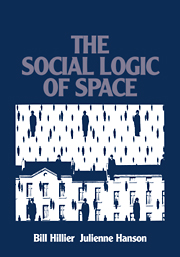Book contents
- Frontmatter
- Contents
- Preface
- Acknowledgements
- Introduction
- 1 The problem of space
- 2 The logic of space
- 3 The analysis of settlement layouts
- 4 Buildings and their genotypes
- 5 The elementary building and its transformations
- 6 The spatial logic of arrangements
- 7 The spatial logic of encounters: a computer-aided thought experiment
- 8 Societies as spatial systems
- Postscript
- Notes
- Index
8 - Societies as spatial systems
Published online by Cambridge University Press: 18 December 2009
- Frontmatter
- Contents
- Preface
- Acknowledgements
- Introduction
- 1 The problem of space
- 2 The logic of space
- 3 The analysis of settlement layouts
- 4 Buildings and their genotypes
- 5 The elementary building and its transformations
- 6 The spatial logic of arrangements
- 7 The spatial logic of encounters: a computer-aided thought experiment
- 8 Societies as spatial systems
- Postscript
- Notes
- Index
Summary
SUMMARY
These concepts are then applied to certain societies whose spatial form is well documented, following which a general theory of the different spatial pathways required by different types of social morphology is sketched. The aim of this theory is to try to relate the existing, well-known evidence into a coherent framework as a basis for further research, rather than to establish a definitive theory.
Some societies
With these concepts in mind, we may now look briefly at a number of societies that differ strongly both in terms of the way they order space, and in terms of their spatial logic as social systems. Obviously, within the scope of this book, this cannot be an exhaustive exercise. All we can do at this stage is to take a number of well-known cases where authors have described spatial properties of societies in such a way that they can be transcribed into the concepts we have used. In doing so we are, of course, adding nothing to the findings of these authors. We are merely using their work to show that the arrangemental model can provide a means for moving from social commentaries to analysis of spatial form. We may begin with the two well-known ethnographies: Fortes on the Tallensi of Northern Ghana, who live in dispersed compounds; and Turner on the Ndembu of Northern Zambia, who live in small circular villages.
Tallensi compounds differ considerably in size and complexity, but always are based on a strong underlying model, which can be seen in the gamma map of the simpler of the two compounds shown in Fig. 131.
- Type
- Chapter
- Information
- The Social Logic of Space , pp. 242 - 261Publisher: Cambridge University PressPrint publication year: 1984



